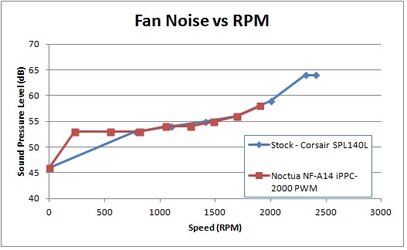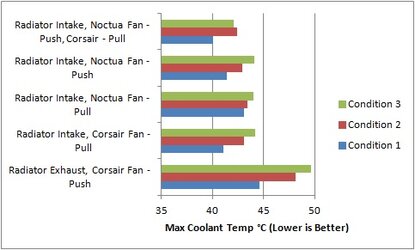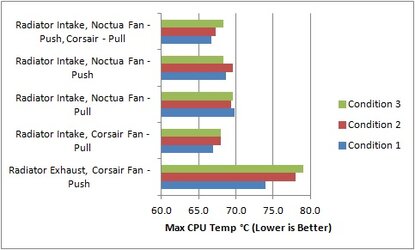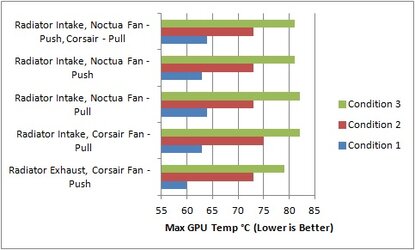- Joined
- Sep 25, 2015
I am the ultimate tweaker...and to that end, I am searching for the best cooling setup for my system...without going to a custom water loop.
My rig is in my signature, highlights:
- 5820 K running at 4.3 GHz
- Corsair H110i GTX AIO for CPU
- 2 GTX 970 running in SLI
The aim for my system is to have quiet. I don't want to have a high performing system at the cost of lots of fan noise. I read a lot of the forums about the best way to setup a water cooling system, but I really couldn't find anything about optimizing things around an AIO. When you add in the heat generated by graphics cards, you start to get an interesting problem that needs to be solved.
I devised a set of experiments to keep the CPU power draw constant, and vary the GPU power to see what effect the GPU power had on overall cooling system efficiency. I kept the primary "guts" of the system the same, and setup different configurations of these within the case.
The result for my system:
1. Radiator as exhaust for hot case air is the worst setup
2. The Noctua NF-A14 iPPC-2000 does not move as much air as the Corsair SPL140L (but it's quieter)

3. A fan "pushing" air through the radiator is superior to a fan "pulling" air through the radiator
--- This is probably due to the "pushing" of air raising the pressure between the fan and the end of the radiator. Higher pressure means more air molecules to grab and move heat.
--- A pull setup only will create a slight vacuum between the fan and the end of the radiator. Lower pressure means less air molecules to grab and move heat.
4. A push/pull configuration is superior to a fan pushing air through the radiator
The change in coolant and CPU temperature is quite astonishing...more than I thought it would be. GPU temperatures do increase some, but not much.
The experimental runs were setup as the following:
--------
Condition #1:
- SETI@Home at 90% of CPU, turn off GPU
- CPU Power at 153 W, GPU power at 95 W (idle)
Condition #2:
- SETI@Home at 90% of CPU, both GPUs running SETI@Home
- CPU Power at 155 W, GPU power at 171 W
Condition #3:
- SETI@Home at 60% of CPU, turn off GPU, Heaven 4.0 running continuously
- CPU Power 152 W, GPU power 290 W
Each run was 30 minutes long.
Before the start of each run, the coolant temperature was brought to 36.2 ± 0.2 °C.
Data was logged with the Open Hardware Monitor and Corsair Link software.
--------
The cooling system configurations where as follows:
Setup #1 (Radiator Exhaust, Corsair Fan Push):
- (3) 120 mm Intake fans in front of case
- (1) 120 mm Exhaust fan in back of case
- AIO radiator on top of case
- Fans pushing hot case air through the radiator to exhaust to outside
- Stock Corsair Fans (SPL140L)
Setup #2 (Radiator Intake, Corsair Fan Pull):
- AIO radiator in front of case
- Fans pulling outside air through radiator
- (2) 120 mm Exhaust fans on top of case
- (1) 120 mm Exhaust fan in back of case
- Stock Corsair Fans (SPL140L) on radiator
Setup #3 (Radiator Intake, Noctua Fan Pull):
- AIO radiator in front of case
- Fans pulling outside air through radiator
- (2) 120 mm Exhaust fans on top of case
- (1) 120 mm Exhaust fan in back of case
- Noctua NF-A14 iPPC-2000 Fans on radiator
Setup #4 (Radiator Intake, Noctua Fan Push):
- AIO radiator in front of case
- Fans pushing outside air through radiator
- (2) 120 mm Exhaust fans on top of case
- (1) 120 mm Exhaust fan in back of case
- Noctua NF-A14 iPPC-2000 Fans on radiator
Setup #5 (Radiator Intake, Noctua Fan Push, Corsair Fan Pull)
- AIO radiator in front of case
- Push/Pull fan configuration, Noctua Push, Corsair Pull
- (2) 120 mm Exhaust fans on top of case
- (1) 120 mm Exhaust fan in back of case
- Noctua NF-A14 iPPC-2000 Fans on radiator
- Stock Corsair Fans (SPL140L) on radiator
--------
Here are the results for max temperatures:
Max AIO Coolant Temperature:

Max CPU Temperature:

Max GPU Temperature:

--------
Next steps:
1. I just ordered 2 more Noctua NF-A14 iPPC-2000 to replace the Corsair SPL140L pull fans on the radiator. Will redo results
2. Replace the 2 GTX 970 graphics cards with 2 GTX 980i Hybrids (i.e. get as much of the graphics heat out of the case as possible)
Thoughts and feedback please (I have lots more pretty graphs if you want to see them!)
My rig is in my signature, highlights:
- 5820 K running at 4.3 GHz
- Corsair H110i GTX AIO for CPU
- 2 GTX 970 running in SLI
The aim for my system is to have quiet. I don't want to have a high performing system at the cost of lots of fan noise. I read a lot of the forums about the best way to setup a water cooling system, but I really couldn't find anything about optimizing things around an AIO. When you add in the heat generated by graphics cards, you start to get an interesting problem that needs to be solved.
I devised a set of experiments to keep the CPU power draw constant, and vary the GPU power to see what effect the GPU power had on overall cooling system efficiency. I kept the primary "guts" of the system the same, and setup different configurations of these within the case.
The result for my system:
1. Radiator as exhaust for hot case air is the worst setup
2. The Noctua NF-A14 iPPC-2000 does not move as much air as the Corsair SPL140L (but it's quieter)

3. A fan "pushing" air through the radiator is superior to a fan "pulling" air through the radiator
--- This is probably due to the "pushing" of air raising the pressure between the fan and the end of the radiator. Higher pressure means more air molecules to grab and move heat.
--- A pull setup only will create a slight vacuum between the fan and the end of the radiator. Lower pressure means less air molecules to grab and move heat.
4. A push/pull configuration is superior to a fan pushing air through the radiator
The change in coolant and CPU temperature is quite astonishing...more than I thought it would be. GPU temperatures do increase some, but not much.
The experimental runs were setup as the following:
--------
Condition #1:
- SETI@Home at 90% of CPU, turn off GPU
- CPU Power at 153 W, GPU power at 95 W (idle)
Condition #2:
- SETI@Home at 90% of CPU, both GPUs running SETI@Home
- CPU Power at 155 W, GPU power at 171 W
Condition #3:
- SETI@Home at 60% of CPU, turn off GPU, Heaven 4.0 running continuously
- CPU Power 152 W, GPU power 290 W
Each run was 30 minutes long.
Before the start of each run, the coolant temperature was brought to 36.2 ± 0.2 °C.
Data was logged with the Open Hardware Monitor and Corsair Link software.
--------
The cooling system configurations where as follows:
Setup #1 (Radiator Exhaust, Corsair Fan Push):
- (3) 120 mm Intake fans in front of case
- (1) 120 mm Exhaust fan in back of case
- AIO radiator on top of case
- Fans pushing hot case air through the radiator to exhaust to outside
- Stock Corsair Fans (SPL140L)
Setup #2 (Radiator Intake, Corsair Fan Pull):
- AIO radiator in front of case
- Fans pulling outside air through radiator
- (2) 120 mm Exhaust fans on top of case
- (1) 120 mm Exhaust fan in back of case
- Stock Corsair Fans (SPL140L) on radiator
Setup #3 (Radiator Intake, Noctua Fan Pull):
- AIO radiator in front of case
- Fans pulling outside air through radiator
- (2) 120 mm Exhaust fans on top of case
- (1) 120 mm Exhaust fan in back of case
- Noctua NF-A14 iPPC-2000 Fans on radiator
Setup #4 (Radiator Intake, Noctua Fan Push):
- AIO radiator in front of case
- Fans pushing outside air through radiator
- (2) 120 mm Exhaust fans on top of case
- (1) 120 mm Exhaust fan in back of case
- Noctua NF-A14 iPPC-2000 Fans on radiator
Setup #5 (Radiator Intake, Noctua Fan Push, Corsair Fan Pull)
- AIO radiator in front of case
- Push/Pull fan configuration, Noctua Push, Corsair Pull
- (2) 120 mm Exhaust fans on top of case
- (1) 120 mm Exhaust fan in back of case
- Noctua NF-A14 iPPC-2000 Fans on radiator
- Stock Corsair Fans (SPL140L) on radiator
--------
Here are the results for max temperatures:
Max AIO Coolant Temperature:

Max CPU Temperature:

Max GPU Temperature:

--------
Next steps:
1. I just ordered 2 more Noctua NF-A14 iPPC-2000 to replace the Corsair SPL140L pull fans on the radiator. Will redo results
2. Replace the 2 GTX 970 graphics cards with 2 GTX 980i Hybrids (i.e. get as much of the graphics heat out of the case as possible)
Thoughts and feedback please (I have lots more pretty graphs if you want to see them!)
